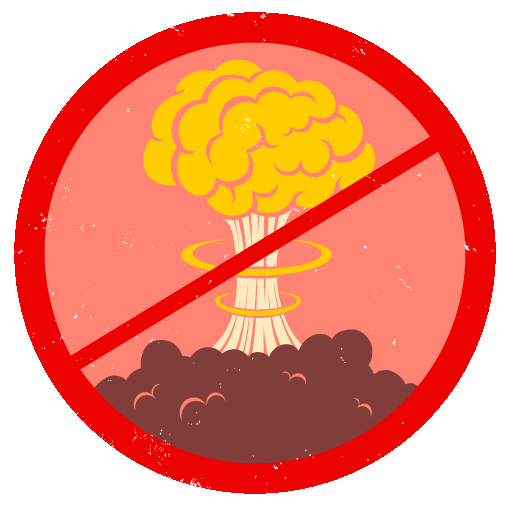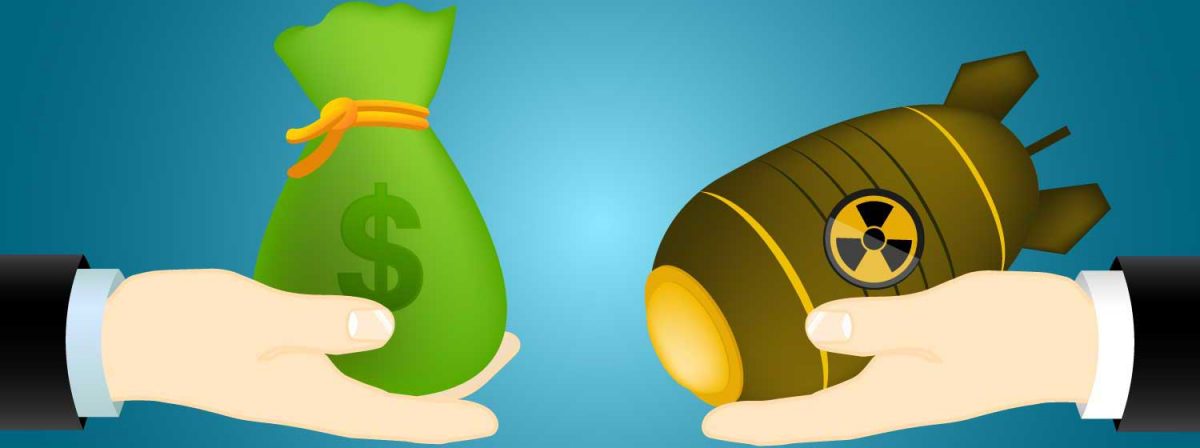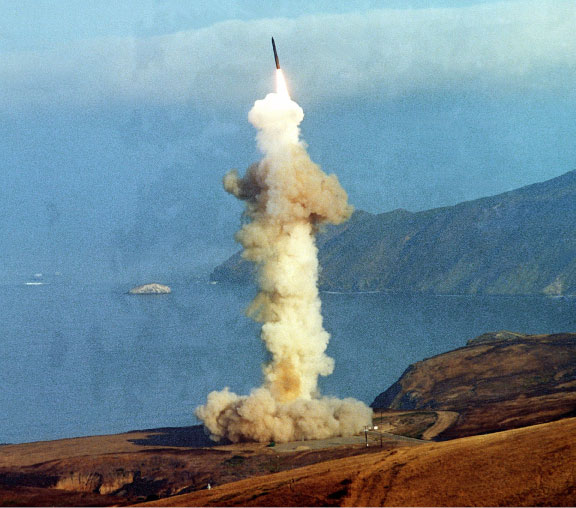Author: Ariel Conn
Alan Robock at TEDxHoboken
On what nuclear winter is and what the impact of a small nuclear war would be. Learn more about Robock’s nuclear winter research here.
Alan Robock; Ph.D. in Meteorology, MIT; Professor II, Rutgers University, New Brunswick, NJ; Lead Author, upcoming Intergovernmental Panel on Climate Change Fifth Assessment Report; Editor, Reviews of Geophysics; Fellow, American Geophysical Union, American Meteorological Society, American Association for the Advancement of Science.
http://envsci.rutgers.edu/~robock/
In the spirit of ideas worth spreading, TEDx is a program of local, self-organized events that bring people together to share a TED-like experience. At a TEDx event, TEDTalks video and live speakers combine to spark deep discussion and connection in a small group. These local, self-organized events are branded TEDx, where x = independently organized TED event. The TED Conference provides general guidance for the TEDx program, but individual TEDx events are self-organized.* (*Subject to certain rules and regulations)

Dr. Ira Helfand | TEDxVail
Ira uncovers the threat to human survival posed by nuclear weapons and what we can do to eliminate this threat. Dangers of nuclear war exist. As an existential threat to humanity, Ira asks you to take action to end nuclear in all forms forever. Together, Ira asks, “Can we prevent nuclear war?”
Ira Helfand, MD is co-President of the International Physicians for the Prevention of Nuclear War, recipient of the 1985 Nobel Peace Prize. As co-Founder and Past President of Physicians for Social Responsibility, IPPNW’s US affiliate, he knows terrible truths about nuclear war.
This talk was given at a TEDx event using the TED conference format but independently organized by a local community. Learn more at http://ted.com/tedx

ABM Treaty or ABMT – Anti-Ballistic Missile Treaty – a 1972 treaty between the United States and the Soviet Union on the limitation of the anti-ballistic missile (ABM) systems used in defending areas against ballistic missile-delivered nuclear weapons. Under the terms of the treaty, each party was limited to two ABM complexes, each of which was to be limited to 100 anti-ballistic missiles. Following the dissolution of the Soviet Union, in 1997 the United States and four former Soviet republics agreed to succeed to the treaty. In June 2002 the United States withdrew from the treaty, leading to its termination.
ALCM – Air Launched Cruise Missile (also called LSRO)
Read Dr. Perry’s case against the new nuclear cruise missile→
BMD – Ballistic Missile Defense
CTBT – Comprehensive Nuclear Test Ban Treaty
Fat Man – The code name for the atomic bomb dropped on Nagasaki, Aug 9, 1945. The name referred to the size and shape of the weapon. It was a plutonium bomb, of the same design tested in the first nuclear explosion, Trinity, on July 16, 1945.
IAEA – International Atomic Energy Agency – an international organization dedicated to promoting the peaceful use of nuclear energy and technology and to prevent its use for military purposes.
ICBM – Intercontinental Ballistic Missile
INF Treaty – Intermediate-Range Nuclear Forces Treaty, signed in 1987, required the United States and the Soviet Union to eliminate and permanently forswear all of their nuclear and conventional ground-launched ballistic and cruise missiles with ranges of 500 to 5,500 kilometers. The treaty marked the first time the superpowers had agreed to reduce their nuclear arsenals, eliminate an entire category of nuclear weapons, and utilize extensive on-site inspections for verification. As a result of the INF Treaty, the United States and the Soviet Union destroyed a total of 2,692 short-, medium-, and intermediate-range missiles by the treaty’s implementation deadline of June 1, 1991. Neither Washington nor Moscow now deploys such systems. Read More→
JASSM – Joint Air to Surface Standoff Missile
JCPOA – Joint Comprehensive Plan Of Action – The JCPOA is more commonly known as the Iran Deal, an international agreement limiting and monitoring Iran’s uranium enrichment to prevent nuclear weapons development.
LRSO – Long Range Standoff Weapon (also called ALCM)
Little Boy – The code name for the atomic bomb dropped on Hiroshima, Aug 6, 1945. The bomb was a gun-type fission weapon using highly enriched uranium as the fuel. The Hiroshima bomb exploded with a force of 15 kilotons of TNT; only a small percentage of the uranium actually underwent fission.
MAD – Mutually Assured Destruction
MIRV – Multiple Independently Targetable Reentry Vehicle (MIRV) is a ballistic missile payload containing several warheads, each capable of being aimed to hit one of a group of targets. By contrast a unitary warhead is a single warhead on a single missile. An intermediate case is the multiple reentry vehicle (MRV) missile which carries several warheads which are dispersed but not individually aimed. Only the United States, Russia, France, and China are known to have developed MIRVed missiles. MIRVed land-based ICBMs were considered destabilizing because they tended to put a premium on striking first.
NATO – North American Treaty Organization
NSNW – Non- Strategic Nuclear Weapons (see tactical nuclear weapons)
SLBM – Submarine Launched Ballistic Missile
SSBM – Ballistic Missile Submarine (colloquially, “boomer”)
START (I & II) – Strategic Arms Reduction Talks
Strategic nuclear weapons – nuclear weapons that can be employed to directly strike an opponent’s country, and in particular their nuclear weapons. Strategic nuclear weapons are the basis of nuclear deterrence (sometimes called Mutually Assured Destruction). The theory of nuclear deterrence holds that if a country possesses a nuclear arsenal that can survive a first strike, and then be used to retaliate, this will effectively inhibit the enemy from attempting such a strike. Thus the mission of strategic nuclear weapons is to prevent the use of nuclear weapons and therefore a nuclear war. The key feature of strategic nuclear weapons is not their design or the size of the warhead, but how they are based and what are their delivery systems.
Tactical Nuclear Weapons – (as opposed to Strategic nuclear weapons) – Tactical nuclear weapons (or Non-Strategic Nuclear Weapons) are weapons designed to be used in fighting wars. While they often have warheads with smaller yields, this is not a requirement of tactical nuclear weapons; the distinction is entirely based on the mission of the weapons, not the design. The United States has backed away from the use of such weapons, fearing that their use would cross the nuclear threshold and could easily lead to rapid escalation. Other countries, notably Russia and Pakistan, have expressly declared that their military strategies rely on the use of tactical nuclear weapons.
TLAM – Tomahawk Land Attack Missile – a long range, subsonic cruise missile that can carry either a nuclear or conventional payload, used for land attack warfare, launched from U. S. Navy surface ships and submarines.
Triad – The United States strategic nuclear weapons force consists of three separate components: ground-based ICBMs; sea-based SLBMs; and air-based gravity bombs and cruise missiles. Proponents of the Triad argue that this diversity decreases the vulnerability of the strategic forces from being destroyed in a sneak attack; others argue that this can be accomplished with just a sea-based system, as modern submarines are extremely difficult to track.
WMD – Weapons of Mass Destruction

WHAT IS THE PLAN TO MODERNIZE NUCLEAR WEAPONS?
Despite decreases in the overall number of nuclear weapons during the administrations of every President since President Johnson, new nuclear weapons continue to be created. President Obama has approved an effort to modernize nuclear weapons, the facilities that create them, and the bombers, submarines, and silos that deliver them.
New weapons include guided nuclear cruise missiles with variable payloads and ICBMs.
New facilities include renovations to a plutonium processing plant in New Mexico, building a high-explosives pressing facility in Texas, and constructing a highly enriched uranium processing plant in Tennessee.
New delivery mechanisms include 12 submarines, up to 100 bombers, and 400 land-based missiles.
WHAT’S WRONG WITH MODERNIZATION?
Source: Arms Control Association
First, the cost is extremely high. The plan described above is projected to cost over $1 trillion over the next thirty years. Cost overruns and delays could cause that figure to rise. It is unlikely that the current level of funding for the Pentagon will be sufficient to cover the cost.
Second, new weapons short circuit deterrence by increasing the likelihood of use in combat. The increased precision and decreased payloads of these weapons make a decision to deploy them in combat thinkable. Nuclear cruise missiles are particularly pernicious. Today, only the U.S., France, and Russia have them in their arsenals. The U.S. plan to create 1,000 of these missiles shuts the door on the possibility of a global ban.
Third, modernization sends the wrong message to other nations. Russia and China have announced plans to expand their nuclear arsenals in response to U.S. modernization plans. Rather than doubling down on a nuclear future, the United States should constructively engage other nations and seek mutual disarmament.
WHAT’S THE ALTERNATIVE TO MODERNIZATION?
Rather than spending billions of dollars on new weapons, facilities, and vehicles, all three could be gradually decommissioned to reduce the total size of the nuclear force. Money could be redirected to reducing recent increases in housing costs for active duty military personnel or improving healthcare for America’s veterans.
HOW WOULD YOU SPEND $1 TRILLION DOLLARS?
If you were given $1 Trillion dollars, what would you spend it on? Free college tuition for all of America for one year? Give everyone in the military a bonus? House the homeless? The Future of Life Institute puts the money in your hands and lets you decide what to spend it on.
READ MORE ABOUT NUCLEAR MODERNIZATION:
As U.S. Modernizes Nuclear Weapons, Smaller Leaves Some Uneasy
Mr. President, Kill the Cruise Missile
Overkill: The Case Against a New Nuclear-Armed Cruise Missile
U.S. Ramping Up Major Renewal in Nuclear Arms

HOW COULD NUCLEAR TERRORISM OCCUR?
Terrorists don’t need to build an ICBM to unleash a nuclear attack on a large population center. The most plausible attack scenarios involve crude nuclear weapons constructed using low-grade fissile material (uranium or plutonium). Such weapons would be compact enough to smuggle into a country without detection. Once a crude weapon is in a country, terrorists would transport it in a vehicle to city and then detonate it in a crowded area.
HOW COULD TERRORISTS ACQUIRE FISSILE MATERIAL?
There are several ways that fissile material could be acquired:
- Black Market: Terrorists may purchase fissile material from arms dealers located in Eastern Europe or the Middle East. A recent report from the Associated Press revealed a large criminal network based in Moldova seeking to sell fissile material to terrorists. The report states, “authorities working with the FBI have interrupted four attempts in the past five years by gangs with suspected Russian connections that sought to sell radioactive material to Middle Eastern extremists.”
- Theft: In many parts of the world, fissile material has minimal security. Experts have focused on Pakistan as a location in which theft is possible; the Nuclear Threat Initiative ranks it as the third-worst for nuclear security (before only North Korea and Iran).
HOW LIKELY IS A NUCLEAR TERRORIST ATTACK?
Various terrorist groups including ISIL have sought to acquire nuclear weapons. Recently, terrorists involved with the March bombing in Brussels planned to kidnap Belgium’s nuclear power chief and attack nuclear power plants. Experts differ on the likelihood of an attack but most believe that it is no longer a matter of if a terrorist attack will occur, but when.
WHAT WOULD HAPPEN IN THE EVENT OF AN ATTACK?
Link to WJP Project Nuclear Nightmare Scenario video
READ MORE ABOUT NUCLEAR TERRORISM:
A New Era for Nuclear Security
Preventing Nuclear Terrorism: Continuous Improvement or Dangerous Decline?

WHAT IS NUCLEAR MISCALCULATION?
Nuclear miscalculation refers to the risk that a state will mistakenly understand the intentions of another state and respond by launching a nuclear strike. The false belief that an attack is imminent causes a country to “miscalculate” the risk of full-scale war and escalate a conflict to the nuclear level. Miscalculation is more likely to occur in times of heightened tension between nations.
WHAT MAKES NUCLEAR MISCALCULATION MORE LIKELY?
The less time allowed between the time a nation detects a suspected launch or act of aggression from another state and launches its own nuclear strike, the higher the risk of nuclear miscalculation. Nuclear weapons in the United States and Russia remain on “hair trigger alert”, a policy whereby launch procedures are started as soon as a nuclear launch is verified. Unfortunately, that process is prone to errors, faulty systems, and false alarms. The extremely short decision period mandated by the hair trigger alert policy and tension inherent to launching a nuclear strike make miscalculation more likely.
Communication failures also contribute to the risk of miscalculation. Closed communication channels between major nuclear powers make it exceedingly difficult to determine the intent of a launch or even to confirm that a launch has occurred. This makes it more likely a false alarm will result in a launch.
HAS MISCALCULATION HAPPENED BEFORE?
While miscalculation has never resulted in a nuclear launch, it has resulted in several extremely close calls.
In 1983, Russian satellite nuclear warning systems detected the launch of five U.S. nuclear missiles at Russia. At the time, there was no identifiable system failure. Were it not for the actions of a skeptical Lt. Colonel who independently reported the event to military leadership as a false alarm, it’s likely that a launch would have occurred.
The Cuban Missile Crisis is another example of a situation in which a nuclear launch was narrowly averted. Russia’s placement of nuclear missiles in Cuba nearly caused the U.S. to invade the country, an event that could have sparked a nuclear war.
Links to WJP Project videos that detail numerous close calls from the Cuban Missile Crisis: